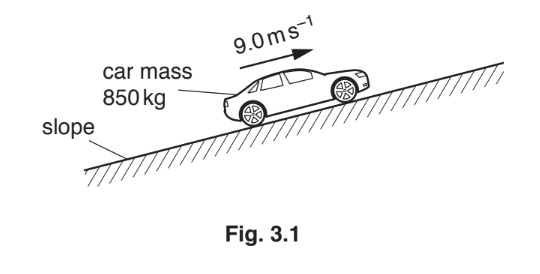Question
A pendulum consists of a solid sphere suspended by a string from a fixed point P, as shown in Fig. 3.1.
The sphere swings from side to side. At one instant the sphere is at its lowest position X, where it has kinetic energy 0.86J and momentum 0.72Ns in a horizontal direction. A short time later the sphere is at position Y, where it is momentarily stationary at a maximum vertical height h above position X.
The string has a fixed length and negligible weight. Air resistance is also negligible.
(a) On Fig. 3.1, draw a solid line to represent the displacement of the centre of the sphere at position Y from position X. [1]
(b) Show that the mass of the sphere is 0.30kg.
(c) Calculate height h.
h = …………………………………………….. m [2]
(d) The distance between point P and the centre of the sphere is 0.93m. When the sphere is at position Y, the string is at an angle θ to the vertical. Show that θ is 47°. [1]
(e) For the sphere at position Y, calculate the moment of its weight about point P.
moment = ………………………………………….. Nm [2]
(f) State and explain whether the sphere is in equilibrium when it is stationary at position Y.
……………………………………………………………………………………………………………………………
Answer/Explanation
Ans:
(a) solid straight line drawn between centre of sphere at X and at Y
(b) 
(c) (Δ)E = mg(Δ)h
h = 0.86 / (0.30 × 9.81)
= 0.29 m
(d) cos θ = (0.93 – 0.29) / 0.93 so θ = 47°
(e) 
(f) there is a resultant force (acting on sphere)
or
there is a resultant moment (about P acting on pendulum)
(so) not in equilibrium
Question
(a) Define velocity.
(b) A car travels in a straight line up a slope, as shown in Fig. 3.1.

The car has mass 850kg and travels with a constant speed of 9.0ms–1. The car’s engine exerts a force on the car of 2.0kN up the slope. A resistive force FD, due to friction and air resistance, opposes the motion of the car. The variation of FD with the speed v of the car is shown in Fig. 3.2.

(i) State and explain whether the car is in equilibrium as it moves up the slope.
(ii) Consider the forces that act along the slope. Use data from Fig. 3.2 to determine the component of the weight of the car that act down the slope.
component of weight = ………………………………………………. N [2]
(iii) Show that the power output of the car is \(1.8 × 10^4\)W.[2]
(iv) The car now travels along horizontal ground. The output power of the car is maintained at 1.8 × 104W. The variation of the resistive force FD acting on the car is given in Fig. 3.2.
Calculate the acceleration of the car when its speed is 15ms–1.
acceleration = …………………………………………..ms–2 [3] [Total: 10]
Answer/Explanation
Ans:
(a) change of displacement /time (taken)
(b)(i) constant velocity, so resultant force is zero
(so car is) in (dynamic) equilibrium
(b)(ii) FD = 0.40 (kN) or 0.40 × 103 (N)
component of weight = 2.0 × 103 – 0.40 × 103
= 1.6 × 103N
(b)(iii) P = Fv
= 2.0 ×103 × 9.0 = 1.8 × 104W
(b)(iv) (driving) force = 1.8 × 104 / 15 (= 1.2 × 103)
FD = 0.66 (kN) or 0.66 × 103(N)
acceleration = (1.2 × 103 – 0.66 × 103)/ 850
= 0.64 (0.635) m s–2
